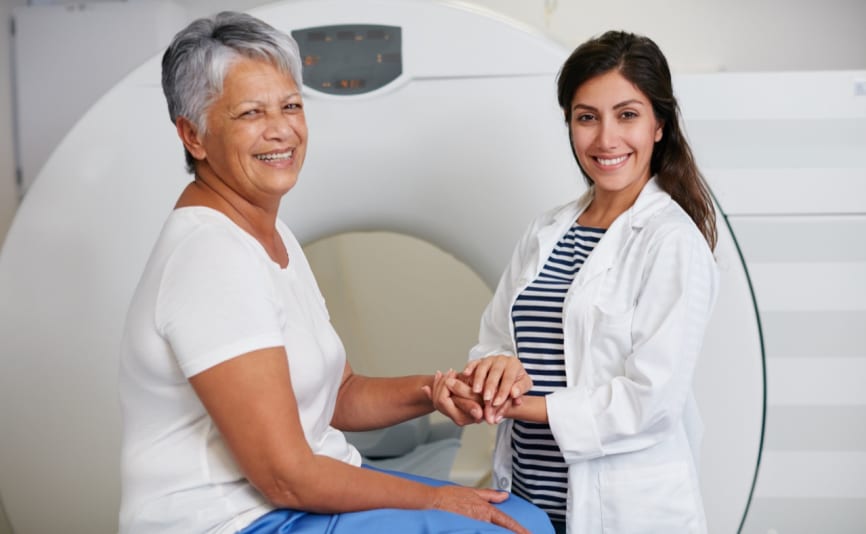We offer three different types of spinal MRI scan: cervical, thoracic and lumbar.
Each type of scan takes images over three planes (directions):
- Axial - from top to bottom
- Sagittal - from one side to the other
- Coronal - from front to back
This allows a clear view of the inner workings of the spine, spinal cord, and surrounding tissues from different angles.
A cervical MRI will scan the soft tissues of your neck and cervical spine. The cervical spine is the part of the spine that runs through your neck, also known as the C1-C7 vertebrae.
The thoracic spine consists of the T1-T12 vertebrae in the middle of your back, and these vertebrae affect the function of hands, arms, fingers, chest muscles, abdominal muscles, reproductive organs and bladder. The thoracic spine also protects the spinal cord, anchors the rib cage, and supports the neck and higher part of the spine (cervical spine).
The lumbar spine consists of the last five vertebrae (L1-L5) between your ribs and pelvis. These vertebrae are larger than those at the top of the spine, as they support a greater weight and absorb more shock.
Usually, your radiologist will already have an idea of what they are looking for in your MRI scan images, from your medical history assessment and any previous physical examinations. However, MRI scans can help to pinpoint specific problems, and can reveal hidden issues a physical examination might miss.
- MRI scans are usually used to check spinal alignment, disc height and hydration, and the shape and appearance of discs (e.g. if they are normal, bulging, or damaged). Subsequent diagnoses could include a herniated disc.
- Stenosis occurs when the spinal canal is not large enough to comfortably accommodate the spinal cord and nerves. This can happen in any part of the spine, but is most common in the lumbar area. Stenosis leads to compression and pressure on the nerves, which can be caused by injury to the spine, tumours, some bone diseases, and arthritis. An MRI scan can help to assess and understand the causes of pain and the best treatment options for stenosis.
- Spinal MRIs can pick up spinal fractures, which can occur in the cervical, thoracic and lumbar parts of the spine. Vertebral fractures can be caused by injury or trauma to the spine, or can be linked with osteoporosis. It is important to seek early diagnosis for spinal fractures so that they can be treated, and further fractures can be prevented.
- An MRI can also identify any pinched or compressed nerves, and any inflammation of the nerves. If you have a radiating pain, burning or tingling in your arms and/or legs, this could be the result of a pinched nerve.
- Other abnormalities that can be found by an MRI scan include artery or vein disorders, abnormal growths or tumours, infection, and some birth defects in the vertebrae or spinal cord. MRIs can also be used to identify degenerative diseases like multiple sclerosis.
- Visit our news page to read more about MRI scans and our services
- Book your private MRI scan today, with a quick referral and fast results from our expert clinicians
- Read our MRI scan frequently asked questions for further information
Sources used
https://www.houstonmri.com/blog/can-you-see-nerve-damage-in-an-mri-21873.html
https://www.thekneedoc.co.uk/magnetic-resonance-imaging-mri-scan/
https://www.healthline.com/health/cervical-mri-scan
https://www.aans.org/en/Patients/Neurosurgical-Conditions-and-Treatments/Cervical-Spine
https://www.radiologyinfo.org/en/info/spinemr
https://www.webmd.com/back-pain/back-pain-spinal-mri
https://www.spine-health.com/conditions/spine-anatomy/thoracic-spine-anatomy-and-upper-back-pain
https://rockymountainbrainandspineinstitute.com/understanding-mri-lumbar-spine/
https://www.hopkinsmedicine.org/health/conditions-and-diseases/lumbar-spinal-stenosis
https://aica.com/will-nerve-damage-show-up-on-an-mri/
https://www.hopkinsmedicine.org/health/treatment-tests-and-therapies/magnetic-resonance-imaging-mri-of-the-spine-and-brain
https://spinesurgeons.ac.uk/The-Spine-and-MRI-Scanning
https://www.ncbi.nlm.nih.gov/pmc/articles/PMC4056125/
https://radiopaedia.org/articles/spinal-fractures?lang=gb






